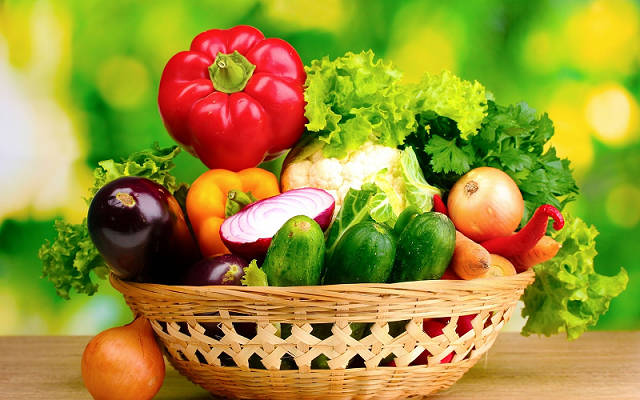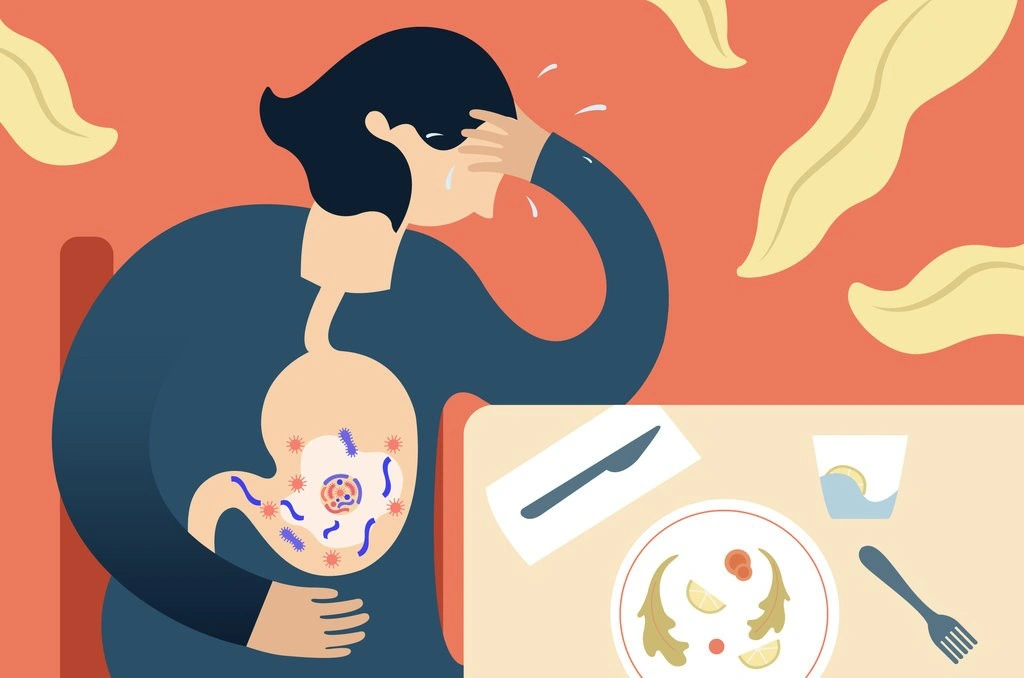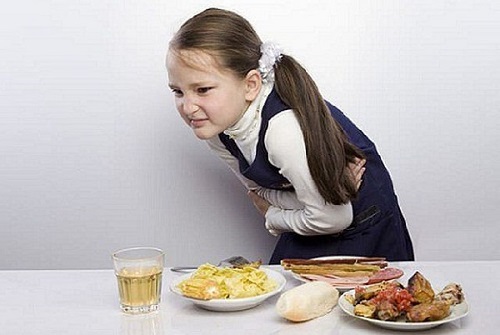What is food poisoning? General principles of food poisoning investigation in Vietnam
What is food poisoning? What are the general principles of food poisoning investigation in Vietnam? - Thuy An (Tien Giang)

What is food poisoning? General principles of food poisoning investigation in Vietnam (Internet image)
Regarding this issue, LawNet would like to answer as follows:
1. What is food poisoning?
According to Clause 1, Article 3 of the Regulations issued together with Decision 39/2006/QD-BYT, food poisoning is an acute syndrome caused by the consumption of food or drink containing hazardous substances, which lead to symptoms in stomach, bowel, nervous system or others depending on the poisoning elements.
2. General principles of food poisoning investigation in Vietnam
General principles of food poisoning investigation according to Article 4 of the Regulations issued together with Decision 39/2006/QD-BYT are as follows:
- Having a thorough grasp of the epidemic situation in local areas to determine if the case is of food poisoning or epidemic.
- Conducting investigations into events that occurred 48 hours or at least 24 hours prior to the time of food poisoning via:
= The patients (if he/she is not in a coma)
= Other people, in order to get information relevant to the food poisoning victims. For examples, what the victim has consumed and his/her symptoms during 24 – 48 hours since his/her consumption of the food or drink.
- Acquiring and understanding the information about clinical symptoms to determine the cause of food poisoning.
- Collecting and storing suspicious food, vomit, colon or gastric lavage liquid, urine, feces and the like of the food poisoning victim, collecting and sending the specimens to preventive medicine centers or professional institutes for testing.
- Inspecting environmental hygiene conditions, food supply, food preparing/storing places, food-serving people and the like, using the regulated forms for the determination of the source and cause of food poisoning.
- Conducting essential tests on patients, in case the poisoning is suspected to result from microorganisms; examining and investigating food serving people.
- In case of fatality, cooperating with police authorities and forensic agencies in conducting and examining pathological autopsy; collecting blood and fluids from digestive tract, heart and lung of the deceased persons for testing.
- Conducting tests on pathology specimens immediately upon the receipt of such specimens. Tests shall vary according to the symptoms.
- Synthesizing and analyzing data, upon the receipt of the on-site investigation results, to determine the time and place of poisoning, number of people consuming the suspicious food, number of decreased people, number of people transferred to hospitals, causal meals, causal food, causal establishments and source of food poisoning as well as providing measures to handle and prevent the situation.
3. Food poisoning investigation methods in Vietnam
According to Article 7 of the Regulations issued together with Decision 39/2006/QD-BYT, use the food poisoning investigation slips to conduct the investigation, investigating staff shall be assigned to specific missions according to the investigation slips:
Investigate individuals suspected of being poisoned, persons having consumed the causal meal, causal establishment, medical practitioners and declarants, epidemic situation in local area; and collect specimens, etc.
Investigators must be honest, unbiased and must abide by the regulations below:
* Investigating people who are poisoned, who ate the suspicious food and who are involved in the poisoning case:
Through poisoned people and relevant ones, the investigator must acquire and list the names of people to be investigated. Investigation must be conducted in form of interview when the investigator has met people who are poisoned and who ate food, using food poisoning investigation slips and food consumption investigation forms. When using such forms, the investigator shall notice:
** Investigation into details of the food poisoning case:
- Use food poisoning investigation slip to investigate specifically the people who have eaten food and got poisoned,
- Determine the incubation and patients’ health conditions.
- Determine whether the poisoned person has attended a party.
** Investigation into the consumption of food:
- Determine whether poisoned people ate the same food. Investigate eating details through the menu of the shared meal, if available.
- Investigate eating details and component of meals within 24 hours (or even 48 to 72 hours, if necessary) before the illness emerges, unless the meal (i.e. shared food) consumed by the victims is specified.
- Determine the peculiarity of the meal (pufferfish, uncooked oyster, blood pudding, animal organs, mushroom, agar-agar, etc.).
- Investigate into drinking water (well-water, spring water).
* Other investigation:
** Investigate people who did not eat the causal food but succumb to the illness or have abnormal symptoms.
** Must not make any suggestion or impression of any food when investigating children. Regarding infants, information shall be obtained from their mothers.
** For cases of false food poisoning, the investigator shall notice if the cases occur due to the surrounding circumstances or rumor.
** Investigate peculiar conditions of residences, workplaces or schools.
** Where the poisoning case is suspected to be caused by pets, transmission routes shall be investigated.
** Where the patient falls sick after or during a tour, his/her activities (i.e. accommodation, meal) and travel schedule and the group's travel plan shall be investigated.
** For foreigners or people who have just entered Vietnam, their activities outside Vietnam before falling sick shall be investigated.
* Investigation at establishments
The investigation at a business establishment which is, or is suspected to be, the origin of food poisoning (including households and establishments declared) shall be recorded into establishment investigation slips or food preparing and storing investigation slips. The investigation shall be conducted in conformity with the following regulations:
** When visiting an establishment subject to investigation, the investigator shall depend on the declaration of the patient (or the complainant) for determining whether or not such establishment is the subject (i.e. comparing the address and phone number of the establishment with the details in the declaration) before conducting the investigation.
** Investigation into food supply:
- Inspect food which the investigated people have eaten.
- Inspect the supply, processing and preparation of food for each menu (box lunch, food for meeting, food served at canteens of schools or hospitals, etc.)
- Investigate people who use the service of the food-supplying establishments.
- Check the list (containing addresses and phone numbers) of buyers, sellers, consumers. Such list must be retained for further investigation.
** Investigation into food processing and preparing:
- Investigate food processing and preparing methods and selling method, transmission routes, germ-increasing conditions, negligence in cooking and so on.
- Inspect the storage of food, applicable to the business subject to inspection (e.g. eating stores, box lunch suppliers, food suppliers providing food for schools, hospitals and hotels providing room and board).
** Investigation into hygienic conditions of establishments:
- Inspect water supplying devices and hygienic conditions of water: measuring redundant chlorine in water; determining the origin of water if taken from sources other than tap-water; inspecting underground water tanks and rooftop water tanks to find out the origin of contamination (i.e. searching for cracks or leaks); inspecting manhole conditions.
- Inspect sewage treatment and maintenance (public and domestic drainage).
- Observe and note down the extermination of pests and harmful animals; examine the survival of such pests and animals.
- Inspect other possible pollutants (insecticides, agricultural medicines, cleansers).
- Where the poisoning case is suspected to be caused by animals (livestock and/or poultry), transmission routes shall be investigated.
- Investigate people who get into and out of food processing and preparing areas.
- Besides, depending on regulations on food safety and hygiene, the investigation shall involve: the suitable conditions of the food preparing sites (i.e. size, temperature, humidity, refrigerator's and freezer’s capacity).
** Investigation into cooking staffs:
- Investigate health conditions of cooking and serving staffs.
- Investigate whether any member of cooking and serving staffs contracted an epidemic disease (for example, typhoid or dysentery) or a virus-borne disease in 1 - 2 prior weeks.
- Investigate whether any member of cooking and serving staffs has just returned from a foreign country.
- Investigate whether any member of cooking and serving staffs has acne, whitlow or pain or works with dirty hands.
- Investigate whether or not members of cooking and serving staffs has a hobby of eating blood pudding or raw fish or other special food.
** Other investigations:
- Check if there are other complaints.
- Investigate whether or not the establishment has conducted self-inspection and produced self-inspection reports.
* Investigate food selling systems and measures
Investigate the market supply chain, depending on the retrospective inspection of the causal food, to discover food poisoning cases or to determine suspicious food, including the inspection of ingredient suppliers and food-selling establishments. The following details must be noticed:
** Investigation into the possibility of pollution caused by germs and chemicals in food.
** Inspection of the compliance with regulations on food storage (food storing standards and measures) during the sale of food.
** Investigate if there are complaints from consumers against the food or the product batch, or if the consumers are affected by such food; investigate the consumers of the food who fall sick.
** If a great amount of such food is sold on a large scale, such case shall be reported to the superior medical agencies and the Department of food safety and hygiene.
* Investigation by interviewing medical practitioners
Food poisoning investigators shall interview medical practitioners who have conducted examination for the patients. The following contents must be specified when a medical practitioner is interviewed:
** Date of examination for the patient.
** Name of the disease.
** Whether or not the patient was hospitalized; in case of admission to a hospital, the expected date of discharge from the hospital.
** Whether or not the patient has received treatment and date that the patient uses the medicines.
** Whether or not the patient has irregular symptoms.
** Whether or not the patient’ feces, blood, vomit specimens have been tested (assign another person to collect such specimens if necessary).
** Whether or not the patient has received examination at the hospital or at another establishment (if any, collect the results).
** If the patient is diagnosed to be poisoned, the food poisoning declaration by the patient shall be presented.
* If the food-poisoned patient is deceased, medical practitioners and relevant people shall be investigated for the following contents:
** Time and developments of the illness since the patient fell sick to the time of his/her death.
** Treatment since hospitalization.
** The investigator shall interview family and relatives of the patient and note down information.
** The investigator shall cooperate with the food hygiene team (of Preventive medicine center) in inspecting and researching other information if necessary.
* Collection of specimens
The entire testing of specimens related to food poisoning (including the people having symptoms) shall be conducted at preventive medicine center or regional institutes.
The collection of specimens is important to clarify the causes of the poisoning case. People in charge of collecting specimens shall have suitable tools. The collection of specimens must be carried out promptly and conformably. Specimens shall be collected in sufficient amount for each type of tests and shall be cryopreserved and shall be promptly transferred so that changes to the specimens are minimized.
** Collection of specimens from patients, consumers and relevant people:
- Feces.
- Vomit.
- Contaminants.
- Remaining food.
- Blood of patients.
- Where the patients are suspected of dying of food poisoning, pathological autopsy shall be conducted. The testing through pathological autopsy must be based on the forensic observation records; specimens of blood, organ, feces and spinal cord of deceased patients must be transferred to research institutes for testing.
** Collection of specimens from establishment and food supply chains:
The following specimens shall be collected from food supply establishments (manufacturing or trading establishments suspected as the causal establishments) and food supply chains (retail-sale stores, processing establishments, whole-sale establishments, delivery establishments).
- Food subject to inspection.
- Remaining food.
- Reference food, including ingredients.
- Cookware, receptacle, package, fridge cleasing tools.
- Tissues for wiping hands.
- Fingers of people working in cooking areas.
- Water.
- Specimens of feces people working at cooking areas.
- Additives, cleansers, disinfectants might be mixed in food.
- Specimens of other substance to be tested (mouse droppings, pet droppings, waste water in drainage ditches).
** When collecting specimens, the following contents shall be investigated:
- Food conditions since it is manufactured until it is sold.
- The relationship between the storage temperature and time (the amount of time for storage at ambient temperature, low temperature, outdoor temperature).
** The storage and transport of specimens shall be cared about:
- Every collected specimen shall be stored in box containing ice which is tightly closed before being transported to ensure that it is not contaminated or modified by time.
- Specimens shall be sent to research institutes or preventive medicine center immediately on the date of collection.
- Key word:
- food poisoning
- in Vietnam
- Cases of land rent exemption and reduction under the latest regulations in Vietnam
- Economic infrastructure and social infrastructure system in Thu Duc City, Ho Chi Minh City
- Regulations on ordination with foreign elements in religious organizations in Vietnam
- Increase land compensation prices in Vietnam from January 1, 2026
- Determination of land compensation levels for damage during land requisition process in Vietnam
- Who is permitted to purchase social housing according to latest regulations in Vietnam?
-

- Strengthening food safety, preventing food poisoning ...
- 18:30, 25/11/2024
-

- Prime Minister to request enhancement of food ...
- 13:43, 12/10/2024
-

- Prime Minister's instruction on strengthening ...
- 10:23, 12/10/2024
-

- Emergency response and search and rescue organizations ...
- 10:29, 11/09/2024
-

- Handling of the acceptance results of ministerial ...
- 09:30, 11/09/2024
-

- Notable new policies of Vietnam effective as of ...
- 16:26, 11/04/2025
-
.Medium.png)
- Notable documents of Vietnam in the previous week ...
- 16:21, 11/04/2025
-
.Medium.png)
- Notable documents of Vietnam in the previous week ...
- 16:11, 02/04/2025
-
.Medium.png)
- Notable new policies of Vietnam to be effective ...
- 16:04, 02/04/2025
-
.Medium.png)
- Notable new policies of Vietnam effective from ...
- 14:51, 21/03/2025

 Article table of contents
Article table of contents
